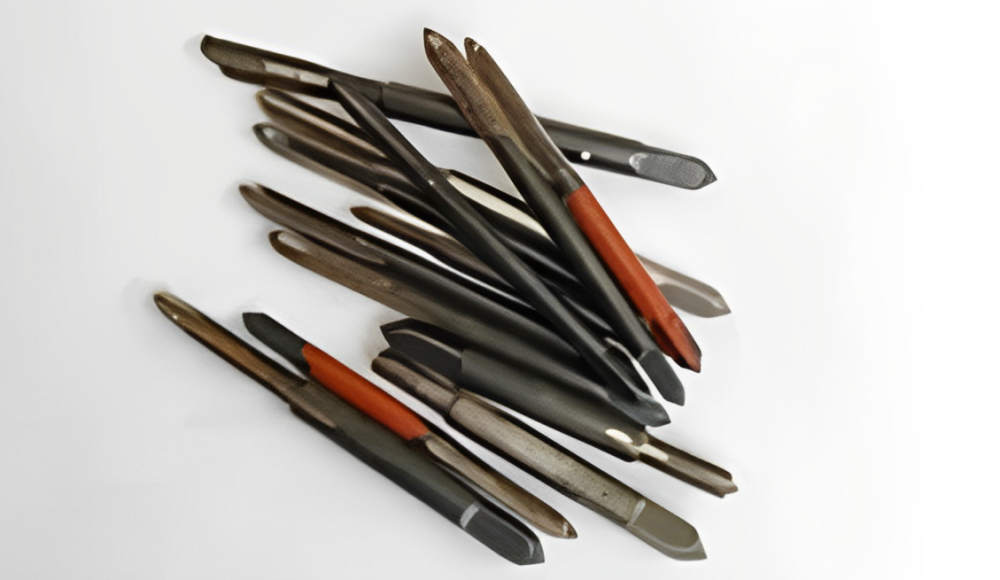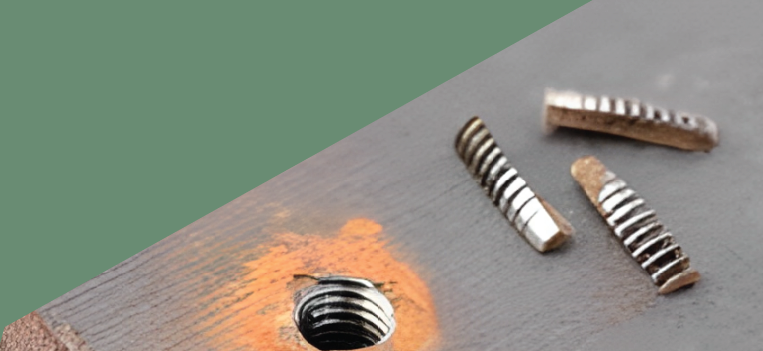El torneado de metales y madera es una actividad central en la mayoría de talleres metalúrgicos y carpinterías.. Proporciona la oportunidad para la creación posterior de una rosca de tornillo interna. Sin embargo, Un grifo de toque elevará la barra para aquellos que comienzan con un proceso y practican artesanos.. La grieta de los grifos se debe a prácticas desfavorables, es decir. Métodos de tapping incorrectos, Aplicar una presión de alto nivel, o la elección incorrecta del material. Entonces, en este articulo, Discutiremos las estrategias efectivas para eliminar los grifos rotos para mantener los hilos en su lugar..
¿Cómo definirías??
Un grifo es un instrumento que se aplica en la rosca de corte dentro de un orificio para aceptar tornillos o pernos. Hay grifos de mano y grifos de máquina. Comúnmente están hechos de acero o carbohidratos de alta velocidad para su uso duradero. Si los usamos apropiadamente, Los grifos producen hilos ordenados y afilados que garantizan una junta perfecta entre dos superficies.
Diez razones principales por las que los grifos se rompen?
Aquí hay algunas razones comunes por las cuales se rompen los grifos:
- Uso incorrecto: Los métodos de golpe defectuosos que pueden resultar desastrosos incluyen no asegurarse de que el grifo esté centrado en el agujero.
- Fuerza excesiva: Se recomienda una cantidad particular de toque a presión mientras tocando, De lo contrario, la herramienta puede romperse en material duro.
- Dureza del material: El grifo se puede estresarse cuando penetra en metales duros.
- Lubricación inadecuada: El uso de fluidos de corte puede evitar la fricción y el puesto, Sobrecalentamiento de la herramienta que causa roturas frecuentes.
- Grifos desgastados o aburridos: Si un usuario decide usar grifos que se han utilizado durante algún tiempo o tener una superficie aburrida. Entonces se necesitará más fuerza que conduzca a las roturas.
- Tamaño de toque incorrecto: Si se usa el lado incorrecto del roscado tapado. Luego ocurren problemas de rosca y el grifo puede romperse.
- Rectificador cruzado: La desalineación contribuye a la entrega cruzada, conduciendo al riesgo de que se rompa el grifo.
- Contaminación por material: Cualquier intrusión de las partículas del suelo, polvo, u otros contaminantes podrían causar un atasco del grifo y sus capacidades de corte.
- Jerks repentinos: Sacar el grifo del agujero puede ser un problema importante. Porque si se atasca, puedes tirar tan fuerte que se rompe.
- Almacenamiento incorrecto: Cuando se almacenan incorrectamente, ya que algunos de los grifos se ven afectados por el almacenamiento incorrecto, Pueden terminar roto.
12 Formas de cómo eliminar los grifos rotos
Entonces, Discutamos algunas de las medidas importantes que podemos tomar para eliminar los grifos rotos:
1. Use un extractor de toque
Los extractores de toque son instrumentos utilizados específicamente para eliminar un toque roto y pueden presionar el grifo para la extracción. Tienen flautas con un extractor que se bloquea en el grifo roto, Asegurar una compra en el material para girarlo en sentido antihorario.
2. Perforarlo
Pinte gradualmente un orificio en el centro del grifo roto, aumentar el tamaño del taladro, y luego retire los restos del grifo. Primero use un tamaño pequeño para obtener un orificio piloto que pueda crear un hilo adicional, y aumentar gradualmente el tamaño. Entonces, puede eliminar el material de grifo sin deformar los otros hilos.
3. Aplicar calor
Tire la luz alrededor del área afectada usando una antorcha para tratar de expandir el metal y probablemente aliviar el grifo atascado. La expansión térmica puede contribuir decisivamente a la interrupción de la adhesión del grifo a la pieza de trabajo, haciéndolo fácilmente extraíble.
4. Usa una broca de la izquierda
Prueba con una broca de la izquierda, Esto puede agarrar directamente sobre el grifo roto y desenroscarlo. La espiral de la izquierda girará en el sentido de las agujas del reloj y en el proceso, se neutraliza y puede capturar el carrete del grifo roto.
5. Use alicates o empuñaduras
Cuando se proyecta cualquier parte del grifo, Se puede eliminar usando alicates o agarres de prensa y luego girar fuera. Asegúrese de que la mano en el grifo no se deslice alrededor de ella.
6. Use un extractor de tornillo
Coloque un extractor de tornillo en el orificio que estaba hecho para sacar el grifo roto y girarlo hormigueando en sentido antihorario. Los extractores de tornillos son cinceles con cortes inversos que se bloquean al grifo cuando lo giras.
7. Tratamientos químicos
Use aceites penetrantes o removedores de óxido para ayudar a romper la tuerca del grifo roto. Algunas de estas sustancias pueden empaparse en el hilo y hacer que un poco de óxido o escombros mantenga el grifo en su lugar para disolverse.
8. Tapping y martillo
Intente saltar por el lugar del grifo dañado para que las vibraciones puedan ayudar a liberar el grifo roto. También puede ayudar a eliminar cualquier escombro que pueda haber causado que el grifo se pegue.
9. Imán
A veces, el tapping está hecho de un material magnético. Si es así, se puede usar un imán fuerte para extraer el grifo. Si se puede acceder a alguna parte del toque, Trae suavemente el imán cerca, y es probable que lo gire.
10. Soldar una tuerca
Pase otra tuerca en el extremo abierto del grifo roto, Esto da un mango para girarlo para la eliminación. Este enfoque desarrolla un buen hilo, en que puedes usar una llave para torcer el grifo roto.
11. Herramienta de dremel
Recorte el grifo con un dremel que lo sostenga hasta que pueda obtener un mejor agarre, O quítalo. Puede ayudar a producir una superficie plana en la parte superior del grifo roto con Dremel.
12. Ayuda profesional
Si nada funciona, Es mejor consultar a maquinistas o trabajadores metálicos para obtener la solución más adecuada.. Tienen las habilidades y procedimientos adecuados para eliminar los grifos rotos sin afectar la pieza de trabajo.
Podemos resumir las causas y sus soluciones en una mesa.:
| Causa | Efecto | Solución |
| Uso incorrecto | Toque la desalineación que conduce a la rotura. | Asegúrese de que el grifo esté centrado en el orificio antes de tocar. |
| Fuerza excesiva | Mayor estrés en el grifo, haciendo que se rompa. | Use la cantidad de presión recomendada mientras aprovecha. |
| Dureza del material | El grifo puede ser excesivo en materiales duros. | Use grifos diseñados específicamente para materiales más duros. |
| Lubricación inadecuada | Aumento de la fricción y sobrecalentamiento de la herramienta. | Siempre aplique fluidos o lubricantes de corte adecuados. |
| Grifos desgastados o aburridos | Se necesita más fuerza, conduciendo a la rotura. | Reemplace los grifos desgastados o aburridos con otros nuevos antes de usar. |
| Tamaño de toque incorrecto | Problemas de enhebrado y posibles roturas de toque. | Verifique que el tamaño de toque correcto se use para el hilo previsto. |
| Rectificador cruzado | Mayor riesgo de rotura del grifo. | Alinee el grifo correctamente para evitar el hilo cruzado. |
| Contaminación por material | Toque Jamming debido a la suciedad o los escombros. | Mantenga el área de trabajo limpia y asegúrese de que no hay contaminantes presentes. |
| Jerks repentinos | Mayor probabilidad de rotura al retirarse. | Evite tirar demasiado fuerte; Utilice las técnicas de extracción adecuadas. |
| Almacenamiento incorrecto | El daño a los grifos puede conducir a la rotura durante el uso. | Almacenar grifos en una caja fuerte, lugar seco para evitar daños. |
Cinco mejores prácticas para crear hilos internos sin romper los grifos
Considerando las causas anteriores y sus soluciones para eliminar el grifo roto. Discutamos algunas prácticas importantes que podemos seguir para evitar la ruptura de tapas:
- Alineación adecuada: Con verdad, Asegúrese de que el grifo se alinee con el orificio para que un productor no pase el toque incorrectamente. Pondrá una presión innecesaria sobre el grifo.
- Use el toque y el tamaño correctos: Peine siempre equipado para reducir los riesgos asociados con la rotura del material para la aplicación.
- Lubricación adecuada: Cortar fluidos para minimizar el contacto del grifo con la pieza de trabajo. Entonces, Puede reducir y minimizar la generación de calor que hace que el grifo se rompa.
- Velocidad y presión controladas: Es necesario aplicar una velocidad de toque lenta y esto no debe estar acompañado de mucha presión para obtener un "corte" suave y suave.
- Limpiar el agujero: La limpieza del hoyo primero es un enfoque aconsejable para evitar golpear cualquier basura y además, La limpieza del agujero hace que el tapping sea más fácil y el riesgo de dañar el grifo más bajo.
Conclusión
En conclusión, puede ser difícil eliminar un grifo roto. Ya, Discutimos cómo minimizar las posibilidades de las roturas de TAP en el futuro si seguimos las prácticas internas de tocado de subprocesos recomendados. Aplicando el conocimiento correcto y utilizando el equipo correcto, Es posible preservar la reputación de su trabajo y lograr los resultados deseados en todos los campos de las partes interesadas.
Preguntas frecuentes
1. ¿Se puede usar un taladro estándar al extraer un grifo roto??
Sí, Pero hay un pequeño cambio que debe tener el tamaño apropiado para el taladro. aparte de esto, Debe tener cuidado de no causar daño a la superficie circundante.
2. ¿Qué se puede hacer para que el (grifos) No se rompa regularmente?
La desalineación, el tipo de tamaño de grifo utilizado, lubricación insuficiente, y la presión excesiva puede causar rotura. Entonces, Evítelos tanto como sea posible.
3. ¿Qué debo hacer cuando se rompe dentro de un material suave??
Algunos materiales pueden ser suaves y pueden eliminarse usando alicates o extraer herramientas sin afectar las otras secciones.
4. ¿Son los extractores de toque una compra valiosa??
Sí, Los extractores de tap se hacen a propósito para este tipo de situación y funcionan mejor para ahorrar tiempo y esfuerzo individuales.
5. ¿Se puede usar el fuego para eliminar un grifo roto??
Sí, El calor puede expandir el metal circundante que mejora la facilidad con la que se retira el grifo. Pero esto debe hacerse tan cuidadosamente para evitar cualquier degradación material.
6. ¿Se pueden reutilizar los grifos rotos??
Se recomienda no reutilizar los grifos viejos porque pueden estar mal construidos o tal vez en una condición de mal ajuste.
7. ¿Qué herramienta debo usar para eliminar un toque roto??
Estos pueden ser extractores de toque, ejercicios, ejercicios de mano izquierda, extractores de tornillo, alicates, y calor.











